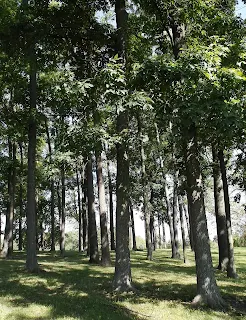The first issue is to select four cities that are approximately 400 miles away. I chose Louisville, Kentucky (370 miles), Dubuque, Iowa (388 miles), Brimley, Michigan (297 miles) and Geneseo, New York (407 miles).
Design priorities:
- Species will be "signature species" for their area.
- Species will produce hard mast, or soft mast, or fix nitrogen, or have high biomass potential. Listed in order of desirability,
- Species that, if not endangered, could use a helping hand.No need to put Cottonwood or Box Elder on this list.
- If the signature species will not thrive, then is there a close substitute that will thrive?
 |
| Jerusalem Artichoke. Variety not known. All photos taken in Eaton County on September 10, 2015. |
Brimley, Michigan Signature species
Northern Red Oak Quercus rubra
Quaking aspen Populus tremuloides (notable because the male catkin buds are the primary winter food for Ruffed Grouse. Male clones preferred)
Eastern White Pine Pinus strobus (See notes on Eastern White Pine "Ridge species")
Beaked Hazel Corylus cornuta
Bracken Fern Pteridium aquilinum
Tag alder Alnus incana (Gray alder A. glutinosa is a Eurasian species that produces a more useful trunk. Both species fix nitrogen)
 |
| Black Walnut. Leaves removed to show clusters of nuts. This variety is Emma Kay |
Geneseo, NY signature species:
American Chestnut Castenea dentata (Replace with Chinese chestnut due to issues with blight)
American Beech Fagus grandifolia
Black Walnut Juglan nigra
Wild Sweet Crab (apple) Malus coronaria (Designers might want to substitute other apple species or hybrids)
 |
| A persimmon tree, branch bending under the load of unripe fruit. This is a variety called Morris Burton. |
South-facing aspect
Louisville, Kentucky signature species:
Persimmon Dioprosia virginiana
Chestnuts (repeat)
Black Locust Robinia pseudoacacia (Fixes nitrogen, biomass)
Swamp Chestnut Oak Quercus michauxii
Shellbark Hickory Carya laciniosa
Red Mulberry Morus rubra
 |
| Staghorn sumac. This is the cutleaf form. Female clones preferred. |
Dubuque, Iowa signature species
Northern Pecans Carya illinoensis
Shagbark Hickory Carya ovata
Bur Oak Quercus macrocarpa
Jerusalem Artichoke Helianthus tuberosus
Staghorn Sumac Rhus typhina
American Plum Prunus americana
Butternut Juglan cinerea
Bitternut Hickory Carya cordiformis
Swamp White Oak Quercus bicolor
Shingle Oak Quercus imbricaria
Silver Maple Acer saccharinum (Locally, 90% of Wood Duck fledgling diets are Silver Maple seeds. Female clones preferred)
Winterberry Ilex verticillata (Female clones preferred)
Succulent Haw Crataegus succulenta (Many, many other species available)
Pussy Willow Salix discolor (Prime bee forage species at a critical time of the year. Male clones preferred)
Ridge species
The cusp of the berm is very dry and exposed. It is also what the public will see.
Ridge above north-facing aspect: Tall grass prairie species. This aspect is already starved for sun so tall shrubs and trees should be avoided.
Ridge above east and west-facing aspects: Staghorn sumac. Produces glorious fall color when starved for moisture and nitrogen. It is also very drought tolerant and displays ornamental clusters of berries during the winter.
Ridge above south-facing aspect: Tall species are OK here because of mimimal risk of shading. Red Cedar (Juniperus virginiana) is very picturesque when windblown but it raises hob with apple trees because it is the alternate host for a species of rust. Eastern White Pine (Pinus strobus) also has the potential to form awesome specimens in windy situations but it is vulnerable to White Pine Blister Rust. Two close relatives of the Eastern White Pine are the Korean Nut Pine (P. koraiensis) and the Swiss Stone Pine (P. cembra) are highly resistant to the rust. Although neither of these pine species are native to North America, their relative disease resistance and the bonus of pine nuts makes them a good "Permaculture" choice.

Don't know where they'll fit best, but I might also suggest working in some elderberry (Sambucus), serviceberry/saskatoons (Amelanchier), and, since you ruled out P.strobus... how 'bout some gooseberries/currants (Ribes).
ReplyDeletePersonally, I'd probably substitute more pecans in place of the bitternut hickory... they'll occupy similar niches... and the nuts are tastier.
I hoped you would comment.
DeleteI omitted small fruits to keep the piece a readable length.
One strength of small fruits is that they are inexpensive and precocious. Ultimately, the site decides what will grow where. You can plant small fruits with abandon and let God sort them out.
William Reid, the sage of Chetopa, Kansas, rolls his eyes when guys from the upper mid-West want to grow pecans. His opinion is that we will unsuccessfully try for 25 years before we wise up and top work the forty foot tree to Yoder hickory. His advice is "Why not start with hickory?"
It is the romance of course. It is the choice between getting the attention of that French exchange student with the exotic accent or Martha from Minnesota. The exchange student defines "high maintenance". Martha keeps a six pack of your favorite beer in her fridge and would never make you sleep on the couch (mostly because she would have to turn up the thermostat). And when Martha cooks, it is not fancy and will never win any ribbons, but it covers the plate and fills the stomach.
Pecans are a strong choice in Kentucky. It makes sense to make the a major part of the portfolio. Up here, they are a high risk, venture capital, niche player.
Again, thanks for commenting. You made me think.
You and Dr. Reid make good points...pushing the envelope is not always successful, and...seedlings, while time to bearing is longer and nut quality will be an unknown, are a lot lower-maintenance than grafted specimens; if a critter (or errant bush-hog) mows them down, they'll re-sprout with no loss of genetic potential... and grafted specimens often require more attention to pruning, as they've lost strong apical dominance, which is a juvenile trait...necessitating some degree of diligence to keep them growing upward without competing leaders or bad branch angles.
DeleteAnd, as I age, Martha from Minnesota has become a lot more appealing...
ReplyDelete